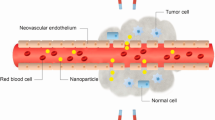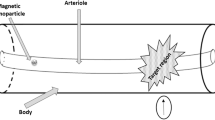Abstract
Motivated by problems arising in magnetic drug targeting, we propose to generate an almost constant Kelvin (magnetic) force in a target subdomain, moving along a prescribed trajectory. This is carried out by solving a minimization problem with a tracking type cost functional. The magnetic sources are assumed to be dipoles and the control variables are the magnetic field intensity, the source location and the magnetic field direction. The resulting magnetic field is shown to effectively steer the drug concentration, governed by a drift-diffusion PDE, from an initial to a desired location with limited spreading.










Similar content being viewed by others
References
Antil H, Hintermüller M, Nochetto R, Surowiec T, Wegner D (2017) Finite horizon model predictive control of electrowetting on dielectric with pinning. Interfaces Free Bound 19(1):1–30
Antil H, Nochetto RH, Venegas P (2018) Optimal control of kelvin force in a bounded domain. Math Models Methods Appl Sci 28:95–130
Bayramov NR, Kraus JK (2015) On the stable solution of transient convectiondiffusion equations. J Comput Appl Math 280:275–293
Braides A (2014) Local minimization, variational evolution and \(\varGamma\)-convergence, vol 2094. Lecture notes in mathematics. Springer, Cham
Brezis H (2011) Functional analysis, Sobolev spaces and partial differential equations. Springer, Berlin
Brezzi F, Marini LD, Pietra P (1989) Two-dimensional exponential fitting and applications to drift-diffusion models. SIAM J Numer Anal 26(6):1342–1355
Choi H, Hinze M, Kunisch K (1999) Instantaneous control of backward-facing step flows. Appl Numer Math 31(2):133–158
Choi H, Temam R, Moin P, Kim J (1993) Feedback control for unsteady flow and its application to the stochastic Burgers equation. J Fluid Mech 253:509–543
Dal Maso G (1993) An introduction to \(\varGamma\)-convergence, vol 8. Progress in nonlinear differential equations and their applications. Birkhäuser Boston Inc, Boston
Dobson J (2006) Gene therapy progress and prospects: magnetic nanoparticle-based gene delivery. Gene Ther 13:283–287
Ern A, Guermond J-L (2004) Theory and practice of finite elements, vol 159. Applied mathematical sciences. Springer, New York
Fountain TWR, Kailat PV, Abbott JJ (2010) Wireless control of magnetic helical microrobots using a rotating-permanent-magnet manipulator. In: 2010 IEEE international conference on robotics and automation (ICRA), pp 576–581
Gijs MAM, Lacharme F, Lehmann U (2010) Microfluidic applications of magnetic particles for biological analysis and catalysis. Chem Rev 110(3):1518–1563
Grief AD, Richardson G (2005) Mathematical modelling of magnetically targeted drug delivery. J Magn Magn Mater 293:455–463
Guermond J-L, Pasquetti R (2013) A correction technique for the dispersive effects of mass lumping for transport problems. Comput Methods Appl Mech Eng 253:186–198
Hintermüller M, Ito K, Kunisch K (2002) The primal-dual active set strategy as a semismooth newton method. SIAM J Optim 13(3):865–888
Hinze M, Kauffmann A (1999) On a distributed control law with an application to the control of unsteady flow around a cylinder. In: Hoffmann KH, Leugering G, Tröltzsch F, Caesar S (eds) optimal control of partial differential equations. ISNM international series of numerical mathematics, vol 133. Birkhäuser, Basel, pp 177–190
Hosu BG, Jakab K, Bánki P, Tóth FI, Forgacs G (2003) Magnetic tweezers for intracellular applications. Rev Sci Instrum 74(9):4158–4163
Johnson C (1987) Numerical solution of partial differential equations by the finite element method. Applied mathematical sciences. Springer, New York
Kelley CT (1999) Iterative methods for optimization. Number 18 in frontiers in applied mathematics. SIAM, Philadelphia
Komaee A, Shapiro B (2011) Magnetic steering of a distributed ferrofluid spot towards a deep target with minimal spreading. In: 2011 50th IEEE conference on decision and control and European control conference (CDC-ECC), pp 7950–7955
Lim JK, Yeap SP, Low SC (2014) Challenges associated to magnetic separation of nanomaterials at low field gradient. Sep Purif Technol 123:171–174
Lübbe AS, Bergemann C, Riess H, Schriever F, Reichardt P, Possinger K, Matthias M, Dörken B, Herrmann F, Gürtler R (1996) Clinical experiences with magnetic drug targeting: a phase I study with 4’-Epidoxorubicin in 14 patients with advanced solid tumors. Cancer Res 56(20):4686–4693
Mahoney AW, Abbott JJ (2011) Managing magnetic force applied to a magnetic device by a rotating dipole field. Appl Phys Lett 99:134103
Markowich PA, Zlámal MA (1988) Inverse-average-type finite element discretizations of selfadjoint second-order elliptic problems. Math Comput 51(184):431–449
Nacev A, Beni C, Bruno O, Shapiro B (2011) The behaviors of ferro-magnetic nano-particles in and around blood vessels under applied magnetic fields. J Magn Magn Mater 323(6):651–668
Nelson BJ, Kaliakatsos IK, Abbott JJ (2010) Microrobots for minimally invasive medicine. Annu Rev Biomed Eng 12:55–85
Petruska AJ, Abbott JJ (2013) Optimal permanent-magnet geometries for dipole field approximation. IEEE Trans Magn 49:811–819
Rosensweig RE (1997) Ferrohydrodynamics. Dover Publications, Mineola
Shapiro A, Dentcheva D, Ruszczyński A (2014) Lectures on stochastic programming: modeling and theory, volume 9 of MOS-SIAM series on optimization. Society for industrial and applied mathematics (SIAM). Mathematical Optimization Society, Philadelphia
Solanki A, Kim JD, Lee K-B (2008) Nanotechnology for regenerative medicine: nanomaterials for stem cell imaging. Nanomedicine 3(4):567–578
Tröltzsch F (2010) Optimal control of partial differential equations: theory, methods and applications, vol 112. Graduate Studies in Mathematics
Xu J, Zikatanov L (1999) A monotone finite element scheme for convection–diffusion equations. Math Comput 68(228):1429–1446
Author information
Authors and Affiliations
Corresponding author
Additional information
The work of H. Antil has been partially supported by NSF Grants DMS-1109325 and DMS-1521590. R. H. Nochetto has been partially supported by NSF Grants DMS-1109325 and DMS-1411808 and P. Venegas has been supported by NSF Grant DMS-1411808 and FONDECYT Project 11160186.
Appendix
Appendix
The stopping criteria considered in Sect. 5 depends on the discrete \(L^2\)-norm of the projected gradient. However, it makes sense to consider the discrete \(H^1\)-norm instead, since the topology is \(H^1\) for the variable \({\varvec{\alpha }}\). With this in mind, we notice that \({\mathcal {J}}'({\varvec{v}}) : V\times V \rightarrow {\mathbb {R}}\), in Theorem 3 with \(V = \{{\varvec{v}} \in [{\mathrm {H}}^1(0,T)]^{n_p} \ : \ {\varvec{v}}(0) = {\varvec{0}} \}\), is linear and continuous. Thus, the Riesz representation theorem implies that, for all \((\bar{{\varvec{\alpha }}},\bar{{\varvec{\theta }}}) \in {\mathcal {H}}_{ad}\times {\mathcal {V}}_{ad}\) there exists an element \(\nabla {\mathcal {J}}(\bar{{\varvec{\alpha }}},\bar{{\varvec{\theta }}}) \in V\times V\) (call it a gradient) such that
To get an expression for \(\nabla {\mathcal {J}}\) in the discrete space, given \(({\varvec{\alpha }}_\tau ,{\varvec{\theta }}_\tau ) \in {\mathcal {H}}^\tau _{ad}\times {\mathcal {V}}^\tau _{ad}\), we solve for \(({\varvec{u}}_\tau ,{\varvec{w}}_\tau ) \in V_\tau \times V_\tau \subset [{\mathrm {H}}^1(0,T)]^{2n_p}\), \(V_\tau :={\mathbb {P}}^1_\tau \cap V\), satisfying
and set \(\nabla {\mathcal {J}}({\varvec{\alpha }}_\tau ,{\varvec{\theta }}_\tau ) = ({\varvec{u}}_\tau ,{\varvec{w}}_\tau )\). By taking into account the previous representative of the gradient, we use projected BFGS to solve the optimization problem with a stopping criterion given by
Here, \({{{\mathbb {P}}}^{\tau }}_{[{\varvec{\alpha }}_*,{\varvec{\alpha }}^*,{\varvec{\theta }}_*,{\varvec{\theta }}^*]}\) denotes the \(H^1\)-projection onto the admissible set \({\mathcal {H}}^{\tau }_{ad}\times {\mathcal {V}}^{\tau }_{ad}\). Next we state how to compute this projection in the continuous setting. If \({\varvec{w}}\in (V\oplus {\varvec{\alpha }}_0)\times ( V\oplus {\varvec{\theta }}_0)\) is given then the \(H^1\)- projection onto \({\mathcal {H}}_{ad}\times {\mathcal {V}}_{ad}\), denoted by \({\varvec{p}}={\mathbb {P}}_{[{\varvec{\alpha }}_*,{\varvec{\alpha }}^*,{\varvec{\theta }}_*,{\varvec{\theta }}^*]}({\varvec{w}})\), is the solution to the following problem: find \({\varvec{p}}\in {\mathcal {H}}_{ad}\times {\mathcal {V}}_{ad}\) such that
We refer to Antil et al. (2018, Appendix A) about how to compute this projection for the continuous case. The same ideas presented for \({\mathcal {J}}\) apply to Problem 2 defined in Sect. 3.2. Notice that, unlike the discrete \(L^2\)-norm considered in Sect. 5, dealing with the \(H^1\)-topology requires the computation of a variational inequality.
We compare the grid-dependence of the optimization algorithm with respect to the \(\ell ^2\)-norm and \(H^1\)-norm. With this in mind, we consider Problem 3.1 with the same \(\varOmega\), T, number of dipoles, \(D_t\), and target vector field \({\mathbf {f}}_2\) as in the second problem of Sect. 5.1. Here the admissible set is characterized by Table 3. The initial guess \(({\varvec{\alpha }}_{int},{\varvec{\phi }}_{int})\) is a constant function given by the initial condition, namely \(({\varvec{\alpha }}_{int}(t),{\varvec{\phi }}_{int}(t))=({\varvec{\alpha }}_0,{\varvec{\phi }}_0)\) for all \(t\in [0,0.75]\). The values of \({\varvec{\alpha }}_0\) and \({\varvec{\phi }}_0\) are motivated by the numerical solution presented in Sect. 5.1 (see Fig. 5). We have solved problem (4.10) with the termination criterion given by (5.1) and (6.10) for the \(\ell ^2\) and \(H^1\) norm topologies, respectively. The tolerance for both cases is set to \({\texttt {Tol}}=3\times 10^{-5}\). The iteration counts for both cases are presented in Table 4. We observe mesh-independence in the iteration for the \(H^1\)-norm topology, with fewer iterations compared to the \(\ell ^2\)-norm topology.
Rights and permissions
About this article
Cite this article
Antil, H., Nochetto, R.H. & Venegas, P. Controlling the Kelvin force: basic strategies and applications to magnetic drug targeting. Optim Eng 19, 559–589 (2018). https://doi.org/10.1007/s11081-018-9392-7
Received:
Revised:
Accepted:
Published:
Issue Date:
DOI: https://doi.org/10.1007/s11081-018-9392-7
Keywords
- Magnetic drug targeting
- Magnetic field design
- Kelvin force
- Non-convex minimization problem
- Dipole approximation




